![]() The Pacific War Online Encyclopedia
The Pacific War Online Encyclopedia
|
| Previous: Arthur Middleton Class, U.S. Attack Transport | Table of Contents | Next: Asaakira Kuni |
This article discusses conventional ground artillery.
Antiaircraft artillery is discussed here and naval gunnery
is discussed here.
Artillery is the branch of the military that specializes in the use of long-range weapons to deliver fire against the enemy. During the Second World War, these weapons were mostly various kinds of tube artillery, though rockets became increasingly important as the war progressed. Tube artillery included mortars, howitzers, and guns of various calibers that fired explosive or chemical projectiles.
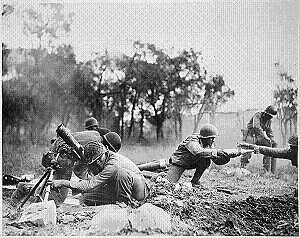
National
Archives. Via Wikipedia
Commons
Mortars are perhaps the oldest form of artillery, dating back to the very beginnings of the use of gunpowder in warfare. A modern mortar is little more than a hollow tube with a firing pin in its base, supported by a base plate and a bipod. Most fired an explosive shell with a propellant cartridge in its tail, which was dropped into the muzzle of the mortar to be set off by the firing pin. The tube was usually unrifled, and stability in flight was achieved by putting fins on the tail of the mortar shell. Mortars were fired at high angles, over 45 degrees, from positions very close to the front line. Thus, mortars were relatively easy to manufacture and transport, had a rapid response time, and could be fired over intervening obstacles. Their nonspinning, low-velocity shells were relatively quiet in flight, giving little warning. On the other hand, mortars have a relatively short range and only moderate accuracy.
The mortars used in the Second World War ranged in caliber from the 50mm German and Japanese models, which were little more than grenade launchers, to giant siege guns. However, the heaviest mortars regularly employed in the Pacific were about 120 mm in caliber. Only heavy mortars were still controlled by the artillery: Light and medium mortars, with calibers less than about 100mm, had become infantry weapons.
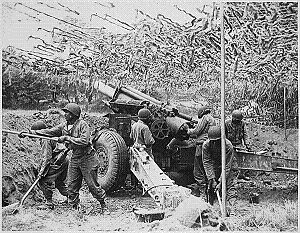
National
Archives. Via Wikipedia
Commons
Howitzers were breech-loaded artillery pieces characterized by a short rifled barrel and large propellant charge. They fired a large shell at moderately high angles, though not as high as mortars. Their range was sufficient that they could be deployed some distance behind the front line. They were otherwise similar to guns.
Because the maximum range for a ballistic projectile is achieved
with a firing angle near 45 degrees, and because a howitzer
typically can be elevated from near horizontal to near vertical,
there are typically two solutions for the firing angle for the
howitzer to hit a target at a given range. The low-angle solution
is usually preferred, because it tends to be considerably more
accurate (less time in flight and less sensitivity to atmospheric
conditions) but it may be necessary to use the high-angle solution
in close terrain where the low-angle solution is obstructed by
ridges or other features. Howitzers firing from small jungle clearings often had to
use the high-angle solution to ensure the rounds would clear the
tree line.
Guns varied in caliber
from 75mm on up. These fired a shell from a long rifled barrel at
high velocity, giving them considerable range and accuracy. The
shells were usually fired at a low angle of elevation and had a
relatively flat trajectory.
Both howitzers and guns required large exposed crews and ammunition dumps that were vulnerable to counterfire. This meant that they were rarely positioned near the front line. As a result, they could not respond as quickly to a call for fire as could mortars. On the other hand, their long range meant that a battery of many guns could cover a large region of the front, bringing down massed fire at any desired point.
Artillery was also classified as light, medium, and heavy. The U.S. Army defined light artillery as all artillery with a caliber of 105mm or less. Medium artillery was essentially limited to the 155mm howitzer, while heavy artillery included the 155mm gun and all larger artillery pieces. Light artillery was valued for its mobility, flexibility, and high rate of fire, which allowed it to provide almost continuous support for the infantry, while medium artillery, which had a lower rate of fire and limited mobility in rugged terrain, was valued for counterbattery fire. Heavy artillery took considerable time to emplace but was valuable for counterbattery and deep interdiction fire.
Artillery Ammunition. Ammunition for howitzers and guns could be either fixed, semi-fixed, or separate loading, as with naval guns. Light artillery generally used fixed ammunition, in which the projectile was fixed to the powder case, much like rounds for small arms. Semi-fixed ammunition, often used in medium artillery, resembled fixed ammunition, except that the projectile could be removed from the powder case by the gun crew. This allowed the crew to remove increments of powder from the case, as a way to adjust the range, before reassembling and loading the round into the artillery piece. Separate loading ammunition, used in heavy artillery, consisted of powder bags, a projectile, and a primer that were loaded separately into the artillery piece.
The projectiles themselves could take several forms. The most common was a simple steel shell casing loaded with high explosive. High explosive shells could have either contact or timed fuses, and by the end of the war, the Allies had also begun using radar proximity fuses on artillery shells. Cartridge rounds had a very thin metal case containing solid shot, which acted something like a shotgun round, spraying the area in front of the artillery piece with shot. This was useful against infantry or to strip cover from enemy fortifications. Shaped-charge rounds (HEAT) were defensive rounds used for direct fire against enemy armor. Chemical rounds saw no use in the war by the Allies but were likely used by the Japanese in China. Smoke rounds, including white phosphorus rounds, were used to generate smoke screens to provide cover for friendly forces; white phosphorus rounds also had some incendiary capability. Illuminating rounds contained a parachute with a calcium or magnesium flare that burned brightly and temporarily illuminated a large area of the battlefield.
Artillery required an extensive logistical tail for the vast
numbers of shells needed to keep the guns firing in heavy combat.
The Allies expended 2.4 million artillery shells at Okinawa between 24 March and 22
June 1945, in an area of less than 60 square miles (155 km2).
However, this was a battle in which artillery (on both sides)
played an unusually large role.
Artillery has four principal effects on the target. The first is suppression, which is hindrance of enemy movement, observation, or manning of equipment. The second is the material effect, which is destruction of enemy equipment or fortifications. The third is lethality, the inflicting of casualties on enemy personnel. The fourth is the moral effect, which is the shock or demoralization of surviving enemy personnel.
The usual role of artillery was to support infantry or armor by hitting targets in their vicinity but beyond the range of their own weapons, or by providing firepower to units whose own fire was inadequate. The long range of artillery meant that artillery batteries did not have to be located close to the units they were supporting, which both protected the artillery and gave it greater tactical flexibility.
Forward artillery observers on Iwo Jima
U.S. Marine Corps. Via ibiblio.org
By the time of the Pacific War, artillery rarely fired at a target the gunners could see. Instead, artillery fire was directed onto its targets by a forward observer who communicated back the coordinates to be fired on and corrections to the aim. Where there was time to prepare observation posts, the forward observers were often equipped with telephone lines back to the batteries. In mobile situations, or when telephone lines were destroyed by counterfire, the observers relied on radio equipment to communicate with the batteries. While greatest accuracy was achieved with registered fire, where a few spotting rounds were fired to check the aim before full fire commenced, this gave away surprise, and it was increasingly common to use predicted fire, where full fire commenced without any spotting rounds based on elaborate targeting calculations. Predicted fire could also be used for targets that could not be observed, such as suspected enemy troop concentrations behind a hill or other cover. Sledge (1981) described such an attack at Okinawa:
At some point during our moves, our mortar section completely wiped out an enemy force that had held an elongated ridge for three days against repeated Marine infantry attacks supported by heavy artillery fire. Burgin was observing. He reasoned that there must have been a narrow gully running along the ridge that sheltered the Japanese from the artillery fire. He registered our three mortars so that one fired from right to left, another from left to right, and the third along the crest of the ridge. Thus the Japanese in the gully couldn't escape....
When we finished firing, the company moved against the ridge. Not a shot was fired at our men. Burgin checked the target area and saw more than fifty freshly killed Japanese soldiers in a narrow ravine, all dead from wounds obviously caused by our mortar fire. the artillery shells had exploded in front of or to the rear of the Japanese who were protected from them. Our 60mm mortar shells fell right into the ravine, however, because of their steeper trajectory.
Air observation became increasingly important to Allied artillery units as the war progressed. This could be provided by light liaison aircraft such as the L-5 Sentinel or the Auster, but only when the Allies had complete control of the air and enemy antiaircraft fire was insignificant. By mid-1944, a pair of light aircraft were part of the TO&E of each U.S. artillery battalion. Otherwise air spotting for artillery required high-performance military aircraft, which were assigned to the mission from the air forces.
Notwithstanding the predominance of indirect fire, there were
situations in which artillery used direct fire, particularly in
the Pacific. Fortress artillery was built into fixed
fortifications and was expected to engage in direct fire.For
example, the Japanese on Okinawa
entrenched a considerable fraction of their artillery in the
forward cave defenses alongside their infantry, where it was less
vulnerable to counterbattery fire and could engage in direct fire
against the attacking Americans.
Direct fire was also used for counterpenetration, typically
against fast-moving enemy armor or mechanized forces, but on 7
July 1944 at Saipan the U.S. Marines broke up a banzai charge with
direct fire using shells fused to detonate 150' (50 meters) from
the muzzles. Urban warfare was
also characterized by the the use of direct fire at short range,
as was the case in Manila in
1945. So was jungle fighting against well-entrenched Japanese,
whose bunkers often could only be reduced by direct hits on their
apertures. Bunker busting became one of the most important
missions of Allied artillery in the Pacific, for which
self-propelled guns were particularly suitable.
The fire missions themselves could take several forms. Harassing fire consisted of an occasional shell fired in the general direction of the enemy, and its purpose was to keep the enemy from resting or moving about freely. Very few casualties were expected from harassing fire, but the psychological effect could be quite significant, particularly at night, as American troops learned early in the Guadalcanal campaign. The Japanese had brought in a few large artillery pieces, but these were very short of ammunition and could engage in little but harassing fire. The Americans nonetheless found the occasional potshots at Henderson Field highly aggravating and nicknamed the unseen Japanese gunner "Pistol Pete." Counterbattery fire was attempted along with ground attack missions by aircraft from the airfield. "Pistol Pete" would make his appearance from time to time through the remainder of the war.
Harassing fire was sometimes quite heavy, in order to deceive the enemy into
believing that an attack was imminent and committing his reserves prematurely or
opening fire with his artillery, thus revealing its positions for
counterbattery fire.
Preparatory fire was intended to weaken enemy positions that were about to be attacked. The intensity of fire was sufficient to destroy communications lines, inflict casualties, and force the defenders to get under deep cover. Prolonged preparatory fire could destroy weaker field works and disrupt barbed wire barriers and minefields. Troops under prolonged artillery fire suffered from reduced morale and longer reaction times. However, a long preparatory barrage sacrificed surprise and often turned the target into a morass through which movement, particularly by vehicles, became very difficult. Preparatory barrages lasting days were not unknown in the First World War, but by the time of the Second World War, most preparatory fire was just long enough to force the defenders into cover and slow their reaction time, after which the attackers attempted to move up before the defenders could recover. This required careful coordination, and many attacks failed, either because the effects of the preparatory fire had worn off by the time the attackers reached the enemy positions, or because the attackers were caught in their own barrage.
Sometimes the attacker would cease fire for a time during a
preparatory barrage, knowing the defenders would then assume an
infantry attack was imminent and move out of deep cover to man
their positions. A second barrage might then catch the defenders
in the open and inflict heavy casualties.
Defensive fire was often prearranged and was aimed at the staging areas from which an enemy attack was being organized. Because attacking troops had to mass and break cover to carry out the attack, well-timed defensive fire could be devastating and stop an attack cold. American artillery saved many an American position faced with a Japanese infantry charge, as at Bloody Ridge at Guadalcanal or on Saipan. In the latter case, the artillery fired directly on massed enemy troops at point blank range before the attack was broken up. Defensive fire directed against enemy assembly areas was known as counterpreparation fire and was effective at Guadalcanal and Bougainville. In March 1944, artillery at Bougainville successfully interdicted reinforcements and permitted destruction of the first Japanese echelon, which was hit in its assembly areas by a counterpreparation concentration of 14,882 rounds.
Counterbattery fire was directed against enemy artillery
positions. Many of the battles of the Second World War opened with
an artillery duel in which each side's artillery sought out the
enemy guns for destruction. However, artillery batteries proved to
be difficult targets and the artillery duel was usually
indecisive. Often the most that was expected was that the
counterbattery fire would "fix" the enemy artillery, hindering its
movement and resupply.
Counterbattery fire was particularly challenging in the Pacific because of the natural cover over much of the terrain. Air reconnaissance or infantry patrols occasionally pinpointed a battery, but much counterbattery fire was harassing fire directed at the sound or flash of the enemy guns. Nevertheless, Allied counterbattery fire became so effective towards the end of the war that the Japanese began parceling out their artillery in concealed positions in the front line, where it presented less of a target. This tendency reached its climax at Okinawa, where heavy guns were sited in mutually supporting positions deeply entrenched in the same coral ridges where most of the Japanese infantry were deployed. The Americans responded by using sound-ranging and flash-spotting equipment and spotter aircraft to pinpoint Japanese guns, then coordinating massive counterbattery fire at the corps level. At one time the artillery of an entire corps was directed against just two Japanese guns.
By the end of the war, the Allies had learned that counterbattery fire was best massed from the corps level. The British made the further innovation of assigning a countermortar officer to each division, prompted by the superb German mortars. The Japanese were also fond of mortars and this command structure would have been equally valuable in the Pacific.
A specialized form of counterbattery fire is counterflack fire, which is directed against antiaircraft defenses. This is possible only when there are friendly ground forces close enough to the operational area of friendly aircraft for the enemy antiaircraft defenses to be in range of artillery. In the Pacific, counterflack fire was most commonly used to protect spotter aircraft operating just beyond the front line.
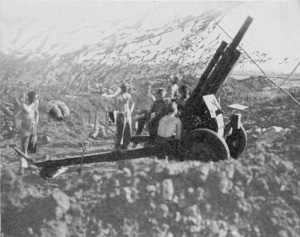
Howitzer under camoflage net
U.S. Marine Corps. Via ibiblio.org
Defense against counterbattery fire, aside from the battery's own counterbattery fire, rested on mobility, dispersion, entrenchment, camouflage, and (in the case of self-propelled artillery) armor. Frequent movements by the battery foil enemy reconnaissance, though at the cost of putting the battery out of operation while it is moving and setting up in its new firing position. Keeping the artillery pieces in a battery well separated from each other made them a less attractive target, though at the cost of complicating fire control. Artillery pieces that were well dug in not only gained a measure of physical protection, but were more easily concealed with camoflage nets. Self-propelled artillery was more easily relocated and better protected against counterbattery fire than towed artillery, but was also much more expensive.
Lacking the means for adequate counterbattery fire, the Japanese tended to rely on teams of infiltrators to neutralize Allied artillery batteries. These consisted of twenty or more men equipped with demolition charges or other special equipment, such as high explosive wrapped around a bamboo pole to be inserted in a barrel and detonated. These teams could lie in wait for days, waiting for the opportunity to silently kill sentries and then make their main attack on the guns. The best defense was alert sentries and aggressive patrolling, and each artillery piece was guarded at night by four pairs of men forming a tight perimeter around the piece.
British artillery batteries in the Arakan in February 1944 were
repeatedly attacked by teams of ten to twelve men, who oddly
turned up every night at the same time and place and were thus
easily repulsed.
Covering fire was used to protect troops in the open from
enemy small arms fire, by
forcing the enemy to take cover. It could be used to assist an
attack after the attacking troops made contact, or, when things
went wrong, it could protect retreating
troops. Covering fire required flexibility and was often best
supplied by the infantry's own mortars.
Interdicting fire was laid on enemy lines of communications to hinder the movement of reinforcements.
By 1944 the Allies had become adept at locating enemy
headquarters and subjecting them to attack. While this was often
the mission of ground air support, long-range artillery also
played a role.
Finally, illuminating fire placed illuminating rounds over the battlefield at night to light up enemy positions or movements.
Artillery could fire a concentration, which was a volume of fire placed on a target area during a limited time frame. Artillery could also fire various kinds of barrages, which was fire placed on a line. The U.S. Army reckoned that a 105mm battery (six guns) could lay down an adequate barrage not more than 300 yards (275m) long, while a 155mm battery (four guns) could lay down a barrage 400 yards (365m) long. A battery was assigned a normal barrage line on which its guns were laid, ready to fire, when not otherwise employed, and it could also be assigned a number of emergency barrage lines that could be quickly fired on when called for. A battery supporting an attack might fire a rolling barrage, where the barrage line moved ahead of the attack according to a prearranged schedule. A box barrage consisted of two barrage lines intended to isolate part of the enemy front.
Sledge (1981) described the experience of being under artillery fire:
Everyone hit the deck. I dove into a shallow crater. The company was completely pinned down. All movement ceased. The shells fell faster, and I couldn't make out individual explosions, just continuous, crashing rumbles with an occasional ripping sound of shrapnel tearing low through the air overhead amid the roar. The air was murky with smoke and dust. Every muscle in my body was as tight as a piano wire. I shuddered and shook as though I were having a mild convulsion. Sweat flowed profusely. I prayed, clenched my teeth, squeezed my carbine stock, and cursed the Japanese....
... I learned a new sensation: utter and absolute helplessness. The shelling lifted in about half an hour, although it seemed to me to have crashed on for hours. Time had no meaning to me. (This was particularly true when under a heavy shelling. I never could judge how long it lasted.) ...
Between the world wars, a number of tactical theorists concluded
that artillery could not keep up with mobile forces and that light bombers would take
the place of artillery. This view was expressed by Kenney in the Southwest
Pacific when he boasted that "The artillery in this theater
flies." The bloody struggle for Buna
demolished this claim. The failure of close air support to replace
artillery forced the major powers to develop various forms of
self-propelled artillery capable of keeping up with fast
mechanized forces, usually consisting of conventional artillery
pieces mounted on tank chassis with light armor for splinter
protection.
The Japanese were handicapped by a relatively weak industrial
base that made it difficult to equip their army with large numbers
of guns and howitzers. When the Army modernized its artillery in
the period 1927-1937, it had to settle for relatively light 75mm
guns and a few 105mm howitzers, because the 2000 artillery pieces
required would have been beyond Japan's industrial capacity if
they had been of heavier caliber. The lighter guns were also
compatible with Japan's tactical doctrine,
which emphasized lightning infantry thrusts supported by highly
mobile artillery. Supplying the guns with adequate ammunition was
also problematic: Production
in 1936 was one-tenth the estimated wartime consumption, and
artillery units suffered serious restrictions on live-fire training. In combat, artillery
tended to be dispersed among supported units and deployed well
forward, with an eye towards careful placement on favorable
terrain, but communications were poor and coordinated fire
uncommon.
The Japanese were fond of mortars, though most of these were smaller infantry mortars. Most infantry divisions had an artillery regiment equipped with 36 75mm howitzers or mountain guns. In a few of the better-equipped divisions, a third of these guns were replaced with 105mm howitzers. Independent mixed brigades typically had eight 75mm howitzers.

Type 38
U.S. Army. Via
ibiblio.org
Japanese howitzers had a distinctly obsolete look to them, since most still used wooden-spoked wheels and were horse-drawn. The chief weapon was the 75mm Improved Type 38 howitzer, with a range of 12,400 yards and a maximum rate of fire of 10-12 rounds per minute. It was clearly an obsolescent weapon, and the Japanese began manufacturing the Type 95 prior to the war, which had some design improvements but only a small improvement in range. The Type 90 was a modern design with rubber tires intended for truck towing, which was deployed primarily in Manchuria. Neither of the newer types were used in great numbers in the Pacific.
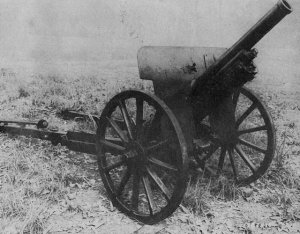
U.S. Army. Via ibiblio.org
The 75mm Type 94 mountain gun could be broken down into eleven
components that could be packed by six horses. Its range was only
9000 yards. It also lacked reliability, judging from the
experience of Guadalcanal, where the Japanese manhandled a single
Type 94 through the jungle to support the attack on Bloody Ridge,
only to discover it had a defective firing pin. The Marines later
discovered the abandoned gun, surrounded by thirty or forty
unexpended shells, each with a slight dimple in its primer where
the firing pin had hit with not quite enough force.

Type 92 gun
U.S. Army. Via ibiblio.org
The 105mm Type 91 howitzer could fire to 11,500 yards at a maximum rate of 6-8 rounds per minute. However, it was not produced in sufficient numbers to equip most divisions. The much superior Type 92 gun, which could fire out to 20,000 yards, was supplied only to non-divisional artillery regiments. A few of these guns made it to Guadalcanal and were known as "Pistol Petes" for their harassing fire. There was also a 105mm mountain howitzer that could fire out to only 6000 yards.
Larger nondivisional artillery pieces included 120mm, 150mm, 240mm and 305mm howitzers; the Type 89 150mm gun; and the Type 98 320mm spigot mortar.
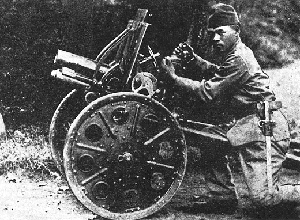
U.S. Army. Via ibiblio.org
The Japanese also developed infantry guns designed to be used close to the front line. The Type 92 70mm infantry howitzer (not to be confused with the Type 92 artillery rifle) could fire an 8.3 pound (3.8 kilogram) shell to 3050 yards (2790 meters). It was most typically used like a long-range mortar, but it could also be used in the direct fire role, and shaped charge shells were provided to allow it to be used in the antitank role. It was allocated 2 to 4 per battalion and could be broken down to be manpacked by ten men. It appeared unreliable and inefficient to Allied intelligence, but remained in use throughout the war, and large numbers were captured by the Chinese Communists in Manchuria and employed in the Chinese civil war.
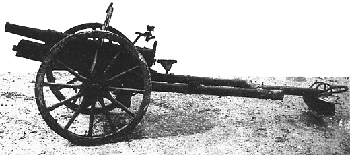
U.S. Army. Via ibiblio.org
The Type 41 75mm regimental gun was a very old design firing a 12.5 pound (5.67 kilogram) shell to 11,990 yards (10,960 meters) that was widely used throughout the war as a direct-fire weapon. It was the first Japanese weapon supplied with a shaped charge for antitank use. With a weight of 1200 pounds (540 kg), it was just light enough to be manhandled into position in the front line, though this required up to twelve men per gun over the difficult terrain characterizing islands like Guadalcanal. It was typically allocated 8 to a regiment.
Both infantry guns were described by British troops as the
"whiz-bang" because of the distinctive sound of the shell in
flight before impact.
U.S. Marine Corps. Via ibiblio.org
The Japanese fielded a number of heavy mortars as artillery,
including a 150mm trench mortar that the Chindits in central Burma found "devastating" (Allen
1984) and a 320mm spigot mortar that saw service at Iwo Jima. The spigot mortar
fired a 675 pound (306 kg) shell and wore out after firing half a
dozen rounds, and it was so erratic that it was almost as
terrifying to its own crews as to Allies.
U.S. Army artillery was modern, well-organized, and plentiful. A standard infantry division was assigned an artillery regiment having 54 105mm howitzers and 12 155m howitzers. This was regarded as the minimum artillery needed for normal combat operations, and additional artillery was allocated from the corps whenever possible for any offensive action against significant opposition. American communications were good, and American artillerists perfected the art of bringing every piece within range to bear on a single target (a "serenade.") The ideal was the TOT or Time On Target attack, in which the more distant batteries fired first so that the shells from all batteries hit the target area at approximately the same time. When properly carried out, a TOT attack could be devastating, since a storm of shells arrived all at once with little warning.
Even on Bataan, the Americans
managed to concentrate 130 guns and howitzers under a single corps
command center, and MacArthur
was sufficiently impressed to describe the artillery to Wainwright as "the
best arm you have" (Bailey 2004).
A Marine artillery regiment initially consisted of two 105mm howitzer battalions and two 75mm pack howitzer battalions for a total of 24 of each type of howitzer. A single 155mm howitzer battalion was added to the artillery regiment just before the Marianas campaign, and one of the 75mm pack howitzer battalions was phased out thereafter.
No U.S. armored divisions saw combat in the Pacific, but they
would have been employed in any invasion
of Japan. An armored division was equipped with an armored
artillery regiment built around 54 M7B1 "Priest" self-propelled
105mm howitzers.
|
M2A1 105mm howitzer National Archives. Via olive-drab.com |
155mm howitzer U.S. Army. Via Wikimedia.org |
The backbone of American artillery was the M2A1 105mm howitzer, which could fire 33 pound (15 kg) shells out to 12,205 yards at a sustained rate of fire of 2 to 4 rounds per minute. The shell was powerful enough to be 50% lethal within a radius of 20 meters. The M2A1 was backed up by the M1 155mm howitzer, with a range of 16,000 yards and a sustained rate of fire of 2 rounds per minute.

U.S. Marine Corps. Via ibiblio.org
U.S. Marine and airborne
forces, for whom mobility was paramount, made use of the M1 75mm
pack howitzer. This weapon could fire a 14.92 lb (6.77 kg) shell
out to 9620 yards (8800m) at a sustained rate of fire of 2 to 3
rounds per minute, though an experienced crew could fire 5 rounds
per minute for short bursts. In addition to an HE shell filled
with 1.47 lbs (0.67) of explosive, the weapon was supplied with a
shaped charge antitank round capable of penetrating roughly 3.5"
(90mm) of armor. The weapon was designed to be broken down into
six pack animal loads which could be reassembled and ready to fire
in as little as three minutes. It could also be towed by a jeep, and one was usually
assigned to each gun in Marine units. At 1440 pounds (653 kg) the
weapon could even be manhandled short distances over easy ground
by its crew of seven. The howitzer was often used for close
infantry support using direct fire against targets at ranges of up
to 700 yards (640 m). It cost about $15,000 and its ammunition
cost about $16 per round.
|
M1 155mm "Long Tom" gun National Archives. Via olive-drab.com |
M4 HST
towing a "Long Tom" National Archives. Via olive-drab.com |
203mm
(8") gun |
A large proportion of the artillery of the U.S. Army was nondivisional. The backbone of the independent artillery regiments was the 155mm M1A1 Long Tom gun, which could fire out to 25,395 yards at a sustained rate of fire of a round per minute. It was paired with the 8" (203mm) howitzer, which could reach out to 18,510 yards at a sustained rate of fire of a round every other minute. Both guns were so heavy that transport was a serious problem. Initially the guns were moved using civilian Mack 6x6 7.5-ton trucks, but by 1943 a purpose-build prime mover, the M4 HST, became available. Most of these heavy artillery pieces were controlled at the corps level.
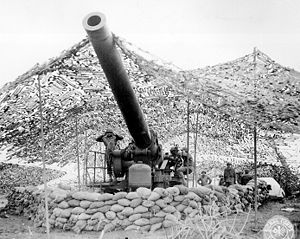
U.S. Army. Via Wikimedia.org
The 240mm M1 Black Dragon howitzer was the heaviest American
artillery piece to see service in the Pacific. These massive
pieces were transported with the T16E1 prime mover, which used
three pairs of medium tank
tracks. The guns were emplaced with the 20-ton Laraine Crane M2, a
process requiring about two hours. However, the Black Dragon could
fire a 360lb (150kg) shell out to 25,225 yards at a rate of a
round every other minute. Though mostly seeing service in Europe,
a battery of Black Dragons participated in the fighting at Manila in early 1945.
A few batteries of 8" (203mm) M1 gun also saw service in the Philippines. This gun could fire shells out to 35,000 yards at a rate of a round per minute.

Australian
short 25-pounder
Australian War Memorial. Via Wikimedia.org
British and Australian infantry divisions were assigned an artillery brigade with 54 to 72 of the 25-pounder gun. This was a versatile 87.6mm weapon with properties intermediate between guns and howitzers. It could fire a 25 lb (11.3 kg) shell out to 12,253 yards, with a normal rate of fire of three rounds per minute, and it was equipped with an armor-piercing round, though this could only penetrate about 1.7" (42mm) of armor. Beginning in 1943, the Australians began fielding a short version of the 25-pounder that was particularly suitable for jungle warfare.
The Australians devised a way to break the gun into components
for air transport, and this was the first artillery to be brought
into action against the Japanese fortifications at Buna. British troops in the Arakan found ways to mount
25-pounders in small landing
craft and barges to support coastal operations. British
armored divisions mounted the gun on tank chassis as the Bishop
and Sexton self-propelled guns, but these were not used in the Far
East.
Nondivisional artillery consisted of 5.5", 6", and 7.2"
howitzers. The 5.5" gun, which saw some service in Burma, could
fire a 100 lb (45 kg) shell to 16,200 yards (14,800 meters) with a
normal rate of fire of a round per minute. The 6" howitzer was an
older weapon that replaced some of the 5.5' guns when the latter
were found to be prone to bore prematures. The 7.2" howitzer was
allocated two per corps in
Burma and could fire a 202 lb (92 kg) shell to 16,900 yards
(15,500 meters) with a normal rate of fire of a round every three
minutes.
References
Chapin
(1994; accessed 2012-7-27)
Evans
(2007; accessed 2012-7-30)
Flowers
(2004; accessed 2012-7-27)
FM
6-20 (1944-2-5; accessed 2012-7-9)
FM 6-150 (1944-8-30; accessed 2012-7-9)
Garand and Strowbridge (1971; accessed 2012-7-27)
Paterson (2001; accessed 2012-7-27)
The Pacific War Online Encyclopedia © 2007-2014, 2016 by Kent G. Budge. Index